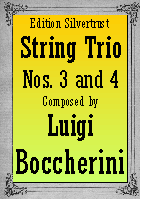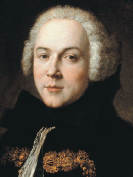Presents
Luigi Boccherini
|
String Trio No.3 |
 |
 |
String Trio No.4 |
String Trios for Violin, Viola & Cello
No.3 in A Major & No.4 in D Major, G.97 & 98
Boccherini wrote over 70 string trios, however, all but a dozen or so are for 2 violins and cello, rather than what became the standard combination of violin, viola and cello. Trio Nos. 3 & 4 are part of a set of six which were published together as his Op.14 in 1772. He was then at the height of his powers. In these trios, the roles and importance of each instrument is constantly varied. While the viola is often the glue between the violin and the cello, at times, it becomes the the soloist. But in these trios, it is the cello that is given a leading role much of the time. The writing spans the entire range of its registers, hopping from deep in its bass to high in its treble clef and requires the extensive use of thumb position.
Luigi Boccherini (1743-1805) was born in the town of Lucca in northern Italy. He studied cello and became a virtuoso. But it was at a time that such players could not yet make a living from touring, so Boccherini found jobs in various orchestras in Vienna and Italy. Boccherini eventually moved to Paris where he hoped to establish himself as an independent soloist and composer but could not and was forced to take employment with the Spanish royal family for the rest of his life.
Boccherini was a very prolific composer writing for virtually every genre which then existed. As a string player, he knew how to make string instruments sound their best. His chamber music shows him as one of the great pioneers of instrumental technique, especially for the cello. He and Haydn were regarded as the two finest composers of third quarter of the 18th century. While today the string quartet is the “King” of chamber music ensembles, during the last half of the 18th century, the string trio was the most popular chamber ensemble and virtually all of the active composers lavished their talents on them. Haydn, Pleyel, Giardini and Mozart, to name but a few, all spent time and effort writing trios.
|
Notes to String Trio No.3 |
Notes to String Trio No.4 |
|
Trio No.3 is four movements and like No.1 ends with a Minuetto, a
traditional ending before 1780. The first movement, Allegro
moderato, begins in a gentle fashion with a gracious melody. The cello is
given the lead with the second theme as the music gradually picks up pace. In
the second movement, Largo, the cello Presents
|
Trio No.4 is in three movements. Although the opening is marked Allegro giusto, the music begins somewhat sedately. It is in the development that the violin breaks out into an energetic episode. The lovely second movement, Andantino, is quite striking. Beginning in hushed fashion, and marked sempre piano, Boccherini creates a wonderful effect from just the barest essentials. In the development, we can hear a soft Spanish accompaniment. The finale, Allegro assai, opens with an explosive upward passage, sometimes called a Mannheim firecracker or rocket as it was a favorite technique of the composers of the Mannheim school. The bumptious and exciting melody and pace make a strong impression. |
These trios are among the finest in the classical literature little gems which we believe professional and amateur trio groups will greatly enjoy.
Trio No.3 Parts: $19.95 / Trio No.4-Parts: $19.95
Special Offer: Both Trios: $29.95